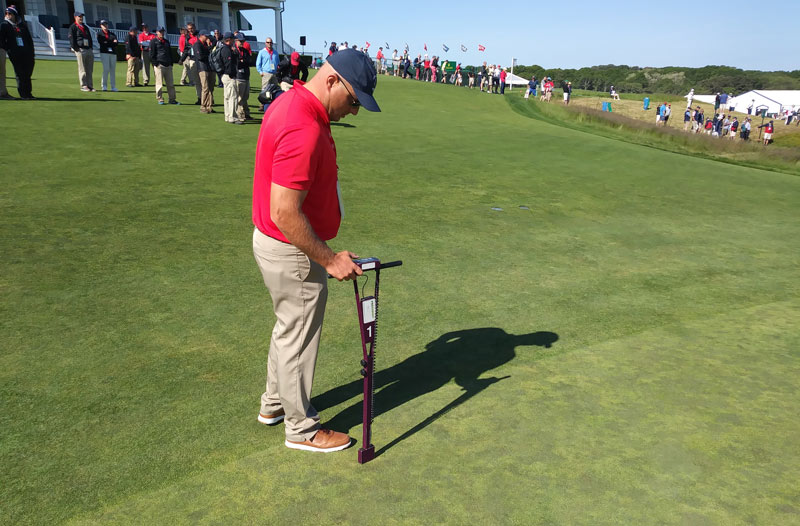
Maintenance volunteer Kyle Elliott from TPC Sawgrass takes soil moisture readings Tuesday at Shinnecock Hills Golf Club. Photo by Howard Richman
A wave of technology means that what happened more than a decade ago at Shinnecock Hills Golf Club will hopefully never happen again — at a major championship golf course or any golf course.
Deterioration to the No. 7 green was an issue in the final round of the 2004 U.S. Open at Shinnecock Hills, located in Southampton, N.Y.
The USGA had issues with it. Golfers had issues with it. Watering wasn’t enough to alleviate it. Fourteen years later, the USGA isn’t shy about talking about it. It’s also not shy about saying that it’s now better equipped to prevent such setbacks.
USGA Green Section director of championship agronomy Darin Bevard says that technological advances have allowed him to share information with Shinnecock Hills superintendent Jon Jennings, CGCS, about how to prevent that type of green issue at this week’s U.S. Open, and for years to come.
“We certainly don’t run from that. We learn from that,” Bevard told GCM about what transpired 14 years ago. “The green became too firm too fast. The biggest concern for Jon (who was not at Shinnecock Hills in 2004) and me was, how are we going to make sure we have the course set up where we want it so we don’t have problems?”
Among the tools being employed to eliminate potential troubles is the FieldScout TDR soil moisture meter, which monitors and records soil moisture. A GreenSight Agronomics drone is used to target, analyze and quickly address turfgrass problems. Matt Pringle, Ph.D., the USGA’s senior director of research, science and innovation, developed TruFirm, which quantifies the firmness of putting greens.
Armed with technological advances such as these, Bevard is pleased with how much has changed since 2004, and that such revolutionary tools are benefiting golf courses the world over, not just those hosting major championships.
“We’re making sure the golf course performs the way we desire it to perform,” Bevard says. “We have a lot of science to work with — moisture meters, more hard data. That will help make sure greens are where we want them and how we want them presented.”
Howard Richman is GCM’s associate editor.